
Rolled oats have long been an ingredient for cookie classics such as oatmeal raisin. Less common is the use of rolled oats as a substitute for regular flour in cookie recipes. Low in cholesterol, high in fiber and considered a whole grain food, rolled oats have long been valued as a healthy breakfast food. Slipping oats into your favorite baked goods adds both nutrition and whole-grain goodness without sacrificing taste.
Quick Oats vs. Rolled Oats
When substituting oats for a portion of the flour in a cookie recipe, you get to choose which kind of oats to use. Both rolled and quick oats are made by steaming and pressing oat groats until flat, and have the same nutritional value. Rolled oats -- also called old-fashioned oats -- are thicker with a more noticeable texture; quick oats are thinner and easier to blend into your batter. To substitute using rolled oats, add them a 1/2 cup at a time until moistened. Steel oats are not recommended for cookies because they are too hard, and instant oats have been pre-cooked and will turn to mush if used in cookie batter.
Substituting for Flour
Whole rolled oats can replace up to 50 percent of the flour in a cookie recipe. Some flour is necessary because oats are heavier than white flour and don’t contain any gluten. Using no flour at all results in dried out, crumbly cookies. Oats are naturally sweeter than wheat flour, so use less sugar when substituting them in place of flour. Add extra leavening to combat the density of rolled oats when using more than 1 cup. To make the substitution, add an additional 1 1/2 teaspoons of baking powder per 1 1/2 cups of rolled oats used, in addition to the rising agent already called for in your recipe.
Making Oat Flour
Substitute oat flour, made from quick or rolled oats, in equal measure for whole wheat flour. Oats are a naturally gluten-free grain, but be aware that most oat crops are cross-contaminated and contain enough gluten to affect those with sensitive allergies. It is possible to purchase gluten-free oats – check the label to be sure. To make your own oat flour, process rolled oats in a coffee grinder, food processor or food mill. Pulse until you have a grain-flecked powder. Whole-grain flours such as oat flour stay fresh longest when refrigerated.
Peanut Butter Exception
It is possible to make a peanut butter cookie without any flour at all by substituting rolled oats, because the peanut butter serves as a natural binding agent. Gluten-free, no-flour peanut butter cookie recipes do not include flour or additional leavening, even though more than 1 cup of oats are used. Blend rolled oats with eggs, peanut butter, sugar and baking soda to make a flourless baked cookie. Non-bake cookies can also be made with peanut butter and rolled oats, using no flour.
Related Articles

Can I Use Rolled Oats in Place of ...
Flour Substitute for Muffins
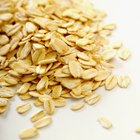
Can You Substitute Quick Cook Oats for ...

Baking With Oats Instead of Flour

What Is White Oat?

Shortbread Cookie Recipe

Can I Substitute Ground Almonds for ...

Substitute for Sorghum in Gingerbread
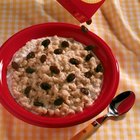
How Many Calories Do Oats Contain?
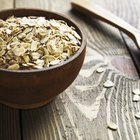
Proteins and Fiber in Oats

What Is the Difference Between Rolled ...
Role of Xanthan Gum in Vegan Baking
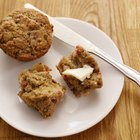
How to Bake With Erythritol

Purpose of Rolled Oats in Baking
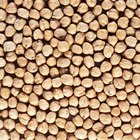
How to Roast Chickpea Flour

What Causes Dry & Hard Muffins?

How to Prepare Quaker Oatmeal

How to Make Pumpernickel Flour

How to Make Quaker Oatmeal
Cooking With Wheat Vs. White Flour
References
- Kitchen Wisdom; Pamela Cross
- Whole Grains Council: Oats
- What’s Cooking America: Ingredient Substitution
Resources
Writer Bio
For more than 10 years, Carol Butler has run a small, off-grid furniture business with her husband and is a regular contributor to the Edible community of magazines. As staff writer for RichLife Advisors, she covers financial planning and other industry-related topics. She holds a B.F.A. in theater arts.
Photo Credits
Jupiterimages/Goodshoot/Getty Images